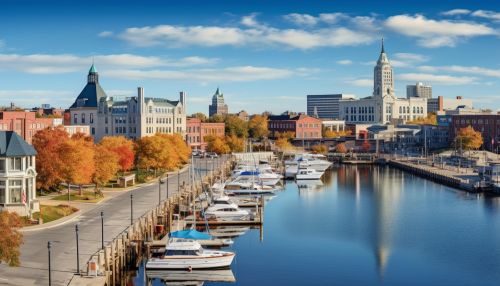Rhode Island
History
Rhode Island, officially known as the State of Rhode Island and Providence Plantations, is the smallest state in the United States in terms of land area. Despite its small size, Rhode Island has a rich and complex history that dates back to the early 17th century.
The first European to explore Rhode Island was Italian navigator Giovanni da Verrazzano, who sailed into Narragansett Bay in 1524 on behalf of France. However, the first permanent European settlement was not established until 1636, when Roger Williams, a religious exile from the Massachusetts Bay Colony, founded the town of Providence on land purchased from the Narragansett Indians.


Rhode Island was one of the original Thirteen Colonies that declared independence from British rule. The state was the first of the Thirteen Colonies to renounce its allegiance to the British Crown on May 4, 1776, and was the last to ratify the United States Constitution on May 29, 1790.
The 19th century saw Rhode Island at the forefront of the Industrial Revolution in the United States. The state was home to Samuel Slater's Mill, the first successful textile mill in the country, and later became a major center for jewelry manufacturing.
In the 20th century, Rhode Island continued to evolve, facing the challenges of economic change and social unrest. Despite these challenges, the state has maintained its unique character and continues to be a vibrant part of the New England region.
Geography
Rhode Island is located in the New England region of the northeastern United States. It is bordered by Connecticut to the west, Massachusetts to the north and east, and the Atlantic Ocean to the south. Despite being the smallest state in terms of land area, Rhode Island has a diverse geography that includes sandy beaches, rolling hills, and densely populated urban areas.
The state is divided into five counties: Bristol, Kent, Newport, Providence, and Washington. Each county has its own unique geographical features and attractions. For example, Newport County is known for its historic mansions and sailing culture, while Providence County is home to the state's capital and largest city, Providence.
Rhode Island's coastline is characterized by numerous bays and inlets, the largest of which is Narragansett Bay. The bay extends into the state and includes several large islands, including Aquidneck Island, home to the city of Newport, and Conanicut Island, home to the town of Jamestown.
The state's highest point is Jerimoth Hill, located in the town of Foster and standing at 812 feet (247 meters) above sea level. Despite its small size, Rhode Island's geography is diverse and offers a variety of landscapes for residents and visitors alike.
Economy
Rhode Island's economy has undergone significant changes over the course of its history. Once a leader in textile manufacturing during the Industrial Revolution, the state's economy has since diversified and now includes a mix of manufacturing, services, and high technology.
Today, Rhode Island's economy is driven by several key sectors. Health services are the state's largest industry, followed by tourism and manufacturing. The state is home to several large companies, including CVS Health, Textron, and Hasbro.
Rhode Island's location on the Atlantic Ocean also makes it a hub for maritime activities. The state has a strong boat building industry, and Newport is known as a premier location for sailing and yachting.
Despite these strengths, Rhode Island's economy faces several challenges. The state has one of the highest unemployment rates in the country, and its per capita income is lower than the national average. However, efforts are being made to diversify the economy and create new opportunities for growth.
Demographics
As of the 2020 U.S. Census, Rhode Island had a population of approximately 1.1 million people, making it the 43rd most populous state in the country. Despite its small size, Rhode Island is one of the most densely populated states in the U.S.
The state's population is diverse, with a mix of different ethnic and racial groups. As of the 2020 Census, approximately 75% of the population identified as White, 16% identified as Hispanic or Latino, 8% identified as Black or African American, and 3% identified as Asian. The state also has a significant population of Portuguese and Italian Americans, reflecting the waves of immigration that have shaped Rhode Island's history.
Rhode Island's population is concentrated in its urban areas, with the largest city, Providence, home to over 180,000 residents. Other major cities include Warwick, Cranston, and Pawtucket.
Education
Rhode Island has a strong commitment to education, with a system that includes public, private, and charter schools, as well as several institutions of higher education.
The Rhode Island Department of Education oversees the state's public K-12 education system, which includes approximately 300 schools serving over 140,000 students. The state also has a number of private and charter schools that offer alternative educational options.
Rhode Island is home to several institutions of higher education, including the Ivy League institution Brown University, the Rhode Island School of Design, and the University of Rhode Island. These institutions contribute to the state's economy and cultural life, and offer a range of academic programs and research opportunities.
Culture
Rhode Island's culture reflects its history, geography, and diverse population. The state is known for its rich maritime tradition, which is celebrated in events like the Newport Jazz Festival and the Newport Folk Festival.
Rhode Island's culinary scene is also a key part of its culture. The state is known for its seafood, particularly clams and lobsters, and is the birthplace of the American diner. Rhode Island is also the home of coffee milk, a unique beverage that was declared the official state drink in 1993.
The state has a vibrant arts scene, with institutions like the Rhode Island School of Design Museum and the Providence Performing Arts Center offering a range of exhibitions and performances. Rhode Island is also home to a number of historic sites, including the Breakers mansion in Newport and the Slater Mill in Pawtucket.
